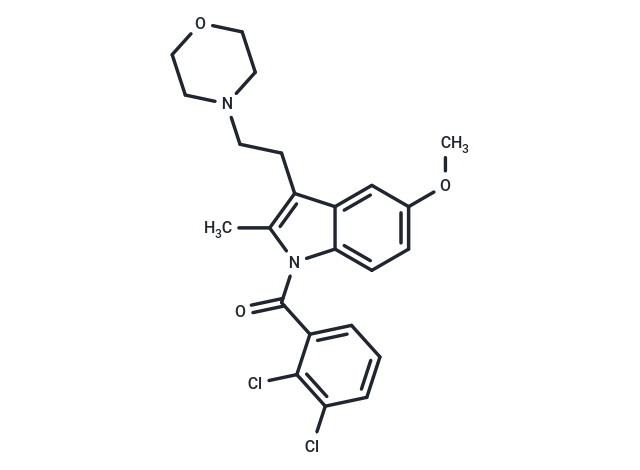Shopping Cart
- Remove All
 Your shopping cart is currently empty
Your shopping cart is currently empty

GW 405833 (L-768242) is an agonist of cannabinoid-2 (CB(2)) receptor-selective

| Pack Size | Price | Availability | Quantity |
|---|---|---|---|
| 1 mg | $31 | In Stock | |
| 5 mg | $80 | In Stock | |
| 10 mg | $122 | In Stock | |
| 25 mg | $222 | In Stock | |
| 50 mg | $347 | In Stock | |
| 100 mg | $515 | In Stock | |
| 1 mL x 10 mM (in DMSO) | $79 | In Stock |
| Description | GW 405833 (L-768242) is an agonist of cannabinoid-2 (CB(2)) receptor-selective |
| In vivo | GW405833 (3, 10, and 30 mg/kg i.p.) dose dependently reversed established mechanical allodynia in both pain models in WT mice;?however, the antiallodynic effects of GW405833 were fully preserved in CB2KO mice and absent in CB1KO mice.?Furthermore, the antiallodynic efficacy of GW405833 (30 mg/kg i.p.) was completely blocked by the CB1 antagonist rimonabant (10 mg/kg i.p.) but not by the CB2 antagonist SR144528 (10 mg/kg i.p.).?Thus, the antinociceptive properties of GW405833 are dependent on CB1 receptors.?GW405833 (30 mg/kg i.p.) was also inactive in a tetrad of tests measuring cardinal signs of CB1 activation.?Additionally, unlike rimonabant (10 mg/kg i.p.), GW405833 (10 mg/kg, i.p.) did not act as a CB1 antagonist in vivo to precipitate withdrawal in mice treated chronically with Δ9-tetrahydrocannabinol[1]. |
| Animal Research | Baseline mechanical paw withdrawal thresholds were measured in each paw for each animal before performing either PSNL or injecting CFA.?Another predrug baseline was then taken after painful peripheral neuropathy or inflammatory pain was fully established.?GW405833 was administered (i.p.) 30 minutes before evaluation of the impact of drug manipulations on mechanical paw withdrawal thresholds.?Different doses of GW405833 were injected (i.p.) within subjects in the order of vehicle (0), 3, 10, and 30 mg/kg.?Sufficient time was allowed to lapse between each dose to verify that mechanical paw withdrawal thresholds returned to the predrug levels before dose escalation. .?In the groups where CB1 or CB2 antagonists were tested, rimonabant or SR144528 (10 mg/kg i.p.) was administered 20 minutes before GW405833 injection[1]. |
| Alias | L-768242 |
| Molecular Weight | 447.35 |
| Formula | C23H24Cl2N2O3 |
| Cas No. | 180002-83-9 |
| Smiles | COc1ccc2n(C(=O)c3cccc(Cl)c3Cl)c(C)c(CCN3CCOCC3)c2c1 |
| Relative Density. | no data available |
| Storage | keep away from moisture | Powder: -20°C for 3 years | In solvent: -80°C for 1 year | Shipping with blue ice. | |||||||||||||||||||||||||
| Solubility Information | DMSO: 10 mg/mL (22.35 mM), Sonication is recommended. | |||||||||||||||||||||||||
Solution Preparation Table | ||||||||||||||||||||||||||
DMSO
| ||||||||||||||||||||||||||

Copyright © 2015-2025 TargetMol Chemicals Inc. All Rights Reserved.